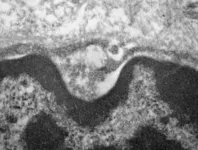(Press-News.org) For the first time, University of Basel researchers have equipped an ultrathin semiconductor with superconducting contacts. These extremely thin materials with novel electronic and optical properties could pave the way for previously unimagined applications. Combined with superconductors, they are expected to give rise to new quantum phenomena and find use in quantum technology.
Whether in smartphones, televisions or building technology, semiconductors play a central role in electronics and therefore in our everyday lives. In contrast to metals, it is possible to adjust their electrical conductivity by applying a voltage and hence to switch the current flow on and off.
With a view to future applications in electronics and quantum technology, researchers are focusing on the development of new components that consist of a single layer (monolayer) of a semiconducting material. Some naturally occurring materials with semiconducting properties feature monolayers of this kind, stacked to form a three-dimensional crystal. In the laboratory, researchers can separate these layers - which are no thicker than a single molecule - and use them to build electronic components.
New properties and phenomena
These ultrathin semiconductors promise to deliver unique characteristics that are otherwise very difficult to control, such as the use of electric fields to influence the magnetic moments of the electrons. In addition, complex quantum mechanical phenomena take place in these semiconducting monolayers that may have applications in quantum technology.
Scientists worldwide are investigating how these thin semiconductors can be stacked to form new synthetic materials, known as van der Waals heterostructures. However, until now, they have not succeeded in combining such a monolayer with superconducting contacts in order to dig deeper into the properties and peculiarities of the new materials.
Superconducting contacts
A team of physicists, led by Dr. Andreas Baumgartner in the research group of Professor Christian Schönenberger at the Swiss Nanoscience Institute and the Department of Physics of the University of Basel, has now fitted a monolayer of the semiconductor molybdenum disulfide with superconducting contacts for the first time. (see box)
The reason why this combination of semiconductor and superconductor is so interesting is that the experts expect components of this kind to exhibit new properties and physical phenomena. "In a superconductor, the electrons arrange themselves into pairs, like partners in a dance - with weird and wonderful consequences, such as the flow of the electrical current without a resistance," explains Baumgartner, the project manager of the study. "In the semiconductor molybdenum disulfide, on the other hand, the electrons perform a completely different dance, a strange solo routine that also incorporates their magnetic moments. Now we would like to find out which new and exotic dances the electrons agree upon if we combine these materials."
Suitable for use as a platform
The electrical measurements at the low temperatures required for superconductivity - just above absolute zero (-273.15°C) - show clearly the effects caused by the superconductor; for example, at certain energies, single electrons are no longer allowed. Moreover, the researchers found indications of a strong coupling between the semiconductor layer and the superconductor.
"Strong coupling is a key element in the new and exciting physical phenomena that we expect to see in such van der Waals heterostructures, but were never able to demonstrate," says Mehdi Ramezani, lead author of the study.
"And, of course, we always hope for new applications in electronics and quantum technology," says Baumgartner. "In principle, the vertical contacts we've developed for the semiconductor layers can be applied to a large number of semiconductors. Our measurements show that these hybrid monolayer semiconductor components are indeed possible -perhaps even with other, more exotic contact materials that would pave the way for further insights," he adds.
Elaborate fabrication process
The fabrication of the new component in a type of sandwich made of different materials requires a large number of different steps. In each step, it is important to avoid contaminations, as they seriously impair the transport of electrical charges.
To protect the semiconductor, the researchers pack a monolayer of molybdenum disulfide between two thin layers of boron nitride, through which they have previously etched the contacts vertically using electron-beam lithography and ion etching. They then deposit a thin layer of molybdenum rhenium as a contact material - a material that retains its superconducting properties even in the presence of strong magnetic fields.
Working under a protective nitrogen atmosphere in a glove box, the researchers stack the boron nitride layer onto the molybdenum disulfide layer and combine the underside with a further layer of boron nitride as well as a layer of graphene for electrical control. The researchers then place this elaborate van der Waals heterostructure on top of a silicon/silicon-dioxide wafer.
INFORMATION:
Abu Dhabi, UAE, July 5, 2021: NYU Abu Dhabi (NYUAD) researchers uncovered a code that sets the genome of the liver to account for the remarkable ability for this organ to regenerate. This finding offers new insight into how the specific genes that promote regeneration can be activated when part of the liver is removed. These findings have the potential to inform the development of a new form of regenerative medicine that could help non-regenerative organs regrow in mice and humans.
While other animals can regenerate most organs, humans, mice, and other mammals can only regenerate their liver in response to an injury or when a piece is removed. NYUAD researchers ...
Post-traumatic stress disorder (PTSD) rings a bell for many, due to its rampant references in pop culture, and more, importantly, its prevalence in today's society. It is only probable that this disorder, which develops after shocking or dangerous events, would unfortunately affect the lives of many people. Medical researchers have been hard at work trying to come up with solutions to combat this condition and its manifestations effectively. Unfortunately, the neurological mechanisms of PTSD aren't clear, and without knowing this exactly, trying to find a cure is a shot in the dark.
Fortunately, a group ...
"Plant a hundred kinds of crops"
Wangjinzhuang village is nestled amongst the steep slopes of the South Taihang Mountains in Hebei Province, China. To prosper in the northern climate, the villagers have developed a tried-and-true strategy: "using the land to plant a hundred kinds of crops and not rely on the sky". Their fields contain red millet, white sorghum, purple and green eyebrow beans, and yellow radishes. Having survived for over a thousand years, this agrobiodiversity is a vibrant cornerstone of the village's agricultural heritage that is too precious to lose.
In an effort to combat dwindling crop diversity across China (the Ministry of Agriculture found that of 11,590 grain crop varieties planted ...
Cardiovascular drugs do not affect COVID-19 outcomes--such as disease severity, hospitalizations, or deaths--according to an analysis of all relevant studies published as of November 2020. The findings are published in the END ...
BOSTON - Significant amounts of atherosclerotic plaque have been found in the coronary arteries of people with HIV, even in those considered by traditional measures to be at low-to-moderate risk of future heart disease, according to a study published in JAMA Network Open.
This finding emerged from the global REPRIEVE (Randomized Trial to Prevent Vascular Events in HIV) study, in which Massachusetts General Hospital (MGH) is playing a key coordinating role. Researchers found that the higher-than-expected levels of plaque could not be attributed simply to traditional cardiovascular disease risk factors like smoking, hypertension, and lipids in the blood, but were independently related to increased arterial inflammation ...
The expected decline in the number of landfills across the United States coupled with bans on disposing large amounts of organic waste in landfills that have been enacted in multiple states has prompted researchers at the U.S. Department of Energy's (DOE's) National Renewable Energy Laboratory (NREL) to examine other ways to grapple with the issue of food waste disposal.
The researchers determined no single solution exists in the United States for dealing with food waste disposal. NREL researchers Alex Badgett and Anelia Milbrandt came to that conclusion after examining the economics involved in five different ways to ...
In Brazil, researchers at the University of São Paulo’s Medical School (FM-USP) have discovered that SARS-CoV-2 infects and replicates in the salivary glands.
Analysis of samples from three types of salivary gland obtained during a minimally invasive autopsy procedure performed on patients who died from complications of COVID-19 at Hospital das Clínicas, FM-USP’s hospital complex, showed that tissues specializing in producing and secreting saliva serve as reservoirs for the novel coronavirus.
The study was supported by FAPESP and reported in an article published in the Journal of Pathology.
The researchers said the discovery ...
Bioenergy crops are an alternative energy source that, unlike fossil fuels, could positively impact the environment by reducing greenhouse gases, soil erosion, and carbon dioxide levels. They can be produced even more sustainably if they are grown on poor quality land unsuitable for food. To make up for the poor land quality, these crops can rely on soil microbes like bacteria and fungi to help them access nutrients and water and store more carbon.
Switchgrass, a native prairie species, is championed as a promising bioenergy crop due to its ability to grow across many climates. ...
BUFFALO, N.Y. - How the media frame stories about science affects the public's perception about scientific accuracy and reliability, and one particular type of narrative can help ameliorate the harm to science's reputation sometimes caused by different journalistic approaches to scientific storytelling, according to a new study led by a University at Buffalo researcher.
"What our experiment shows is that the way the news media talk about science focuses too much attention on individuals in a way that doesn't accurately describe the way science actually works," says ...
Amid calls for racial and social justice nationwide, businesses and educational institutions are grappling with how to adopt more inclusive organizational practices, including more diversified hiring. However, recruitment teams and strategic leaders often blame their lack of a diverse workforce on a lack of diverse applicants. A large study of recruitment data suggests a simple and efficient way of increasing diversity in applicant pools: have more diverse recruitment committees and leadership teams.
The study, led by researchers at the University of Houston's Center for ADVANCING ...



